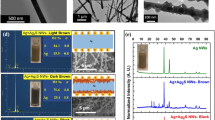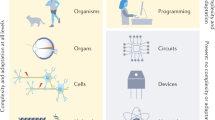Abstract
The accumulation and extrusion of Ca2+ in the pre- and postsynaptic compartments play a critical role in initiating plastic changes in biological synapses. To emulate this fundamental process in electronic devices, we developed diffusive Ag-in-oxide memristors with a temporal response during and after stimulation similar to that of the synaptic Ca2+ dynamics. In situ high-resolution transmission electron microscopy and nanoparticle dynamics simulations both demonstrate that Ag atoms disperse under electrical bias and regroup spontaneously under zero bias because of interfacial energy minimization, closely resembling synaptic influx and extrusion of Ca2+, respectively. The diffusive memristor and its dynamics enable a direct emulation of both short- and long-term plasticity of biological synapses, representing an advance in hardware implementation of neuromorphic functionalities.
This is a preview of subscription content, access via your institution
Access options
Subscribe to this journal
Receive 12 print issues and online access
$259.00 per year
only $21.58 per issue
Buy this article
- Purchase on Springer Link
- Instant access to full article PDF
Prices may be subject to local taxes which are calculated during checkout






Similar content being viewed by others
References
Diorio, C., Hasler, P., Minch, B. A. & Mead, C. A. A single-transistor silicon synapse. IEEE Trans. Electron Dev. 43, 1972–1980 (1996).
Indiveri, G., Chicca, E. & Douglas, R. A VLSI array of low-power spiking neurons and bistable synapses with spike-timing dependent plasticity. IEEE Trans. Neural. Netw. 17, 211–221 (2006).
Bartolozzi, C. & Indiveri, G. Synaptic dynamics in analog VLSI. Neural Comput. 19, 2581–2603 (2007).
Chua, L. Memristor-The missing circuit element. IEEE Trans. Circuit Theory 18, 507–519 (1971).
Terabe, K., Hasegawa, T., Nakayama, T. & Aono, M. Quantized conductance atomic switch. Nature 433, 47–50 (2005).
Waser, R. & Aono, M. Nanoionics-based resistive switching memories. Nat. Mater. 6, 833–840 (2007).
Kwon, D.-H. et al. Atomic structure of conducting nanofilaments in TiO2 resistive switching memory. Nat. Nanotech. 5, 148–153 (2010).
Wedig, A. et al. Nanoscale cation motion in TaOx, HfOx and TiOx memristive systems. Nat. Nanotech. 11, 67–74 (2016).
Jo, S. H. et al. Nanoscale memristor device as synapse in neuromorphic systems. Nano Lett. 10, 1297–1301 (2010).
Yu, S., Wu, Y., Jeyasingh, R., Kuzum, D. & Wong, H. S. P. An electronic synapse device based on metal oxide resistive switching memory for neuromorphic computation. IEEE Trans. Electron Devices 58, 2729–2737 (2011).
Ohno, T. et al. Short-term plasticity and long-term potentiation mimicked in single inorganic synapses. Nat. Mater. 10, 591–595 (2011).
Wang, Z. Q. et al. Synaptic learning and memory functions achieved using oxygen Ion migration/diffusion in an amorphous InGaZnO memristor. Adv. Funct. Mater. 22, 2759–2765 (2012).
Lim, H., Kim, I., Kim, J. S., Hwang, C. S. & Jeong, D. S. Short-term memory of TiO2-based electrochemical capacitors: empirical analysis with adoption of a sliding threshold. Nanotechnology 24, 384005 (2013).
La Barbera, S., Vuillaume, D. & Alibart, F. Filamentary switching: synaptic plasticity through device volatility. ACS Nano 9, 941–949 (2015).
Prezioso, M. et al. Training and operation of an integrated neuromorphic network based on metal-oxide memristors. Nature 521, 61–64 (2015).
Pershin, Y. V. & Di Ventra, M. Experimental demonstration of associative memory with memristive neural networks. Neural Netw. 23, 881–886 (2010).
Pershin, Y. V. & Di Ventra, M. Practical approach to programmable analog circuits with memristors. IEEE Trans. Circuits Syst. I 57, 1857–1864 (2010).
Pershin, Y. V. & Di Ventra, M. Memristive circuits simulate memcapacitors and meminductors. Electron. Lett. 46, 517–518 (2010).
Kim, S. et al. Experimental demonstration of a second-order memristor and its ability to biorealistically implement synaptic plasticity. Nano Lett. 15, 2203–2211 (2015).
Du, C., Ma, W., Chang, T., Sheridan, P. & Lu, W. D. Biorealistic implementation of synaptic functions with oxide memristors through internal ionic dynamics. Adv. Funct. Mater. 25, 4290–4299 (2015).
Xu, Z., Bando, Y., Wang, W., Bai, X. & Golberg, D. Real-time in situ HRTEM-resolved resistance switching of Ag2S nanoscale ionic conductor. ACS Nano 4, 2515–2522 (2010).
Liu, Q. et al. Real-time observation on dynamic growth/dissolution of conductive filaments in oxide-electrolyte-based ReRAM. Adv. Mater. 24, 1844–1849 (2012).
Yang, Y. et al. Observation of conducting filament growth in nanoscale resistive memories. Nat. Commun. 3, 732 (2012).
Yang, Y. et al. Electrochemical dynamics of nanoscale metallic inclusions in dielectrics. Nat. Commun. 5, 4232 (2014).
Tian, X. et al. Bipolar electrochemical mechanism for mass transfer in nanoionic resistive memories. Adv. Mater. 26, 3649–3654 (2014).
Hubbard, W. A. et al. Nanofilament formation and regeneration during Cu/Al2O3 resistive memory switching. Nano Lett. 15, 3983–3987 (2015).
Jo, S. H., Kumar, T., Narayanan, S., Lu, W. D. & Nazarian, H. Electron Devices Meeting (IEDM) 6.7.1–6.7.4 (IEEE International, 2014).
Song, J., Woo, J., Prakash, A., Lee, D. & Hwang, H. Threshold selector with high selectivity and steep slope for cross-point memory array. IEEE Electron Device Lett. 36, 681–683 (2015).
Yang, H. et al. 2015 Symp. VLSI Technology (VLSI Technology) T130–T131 (IEEE International, 2015).
Luo, Q. et al. Electron Devices Meeting (IEDM) 10.14.11–10.14.14 (IEEE International, 2015).
Voorhees, P. W. The theory of Ostwald ripening. J. Stat. Phys. 38, 231–252 (1985).
Stoneham, A. M. Systematics of metal–insulator interfacial energies: a new rule for wetting and strong catalyst-support interactions. Appl. Surf. Sci. 14, 249–259 (1983).
Sun, J. et al. Liquid-like pseudoelasticity of sub-10-nm crystalline silver particles. Nat. Mater. 13, 1007–1012 (2014).
Valov, I. & Staikov, G. Nucleation and growth phenomena in nanosized electrochemical systems for resistive switching memories. J. Solid State Electrochem. 17, 365–371 (2012).
van den Hurk, J., Linn, E., Zhang, H., Waser, R. & Valov, I. Volatile resistance states in electrochemical metallization cells enabling non-destructive readout of complementary resistive switches. Nanotechnology 25, 425202 (2014).
Guzman, D. M., Onofrio, N. & Strachan, A. Stability and migration of small copper clusters in amorphous dielectrics. J. Appl. Phys. 117, 195702 (2015).
Hasegawa, T., Terabe, K., Tsuruoka, T. & Aono, M. Atomic switch: atom/ion movement controlled devices for beyond von-Neumann computers. Adv. Mater. 24, 252–267 (2012).
Valov, I. et al. Atomically controlled electrochemical nucleation at superionic solid electrolyte surfaces. Nat. Mater. 11, 530–535 (2012).
Tsuruoka, T. et al. Effects of moisture on the switching characteristics of oxide-based, gapless-type atomic switches. Adv. Funct. Mater. 22, 70–77 (2012).
Valov, I. & Lu, W. D. Nanoscale electrochemistry using dielectric thin films as solid electrolytes. Nanoscale 8, 13828–13837 (2016).
Yi, W. et al. Quantized conductance coincides with state instability and excess noise in tantalum oxide memristors. Nat. Commun. 7, 11142 (2016).
Burgoyne, R. D. Neuronal calcium sensor proteins: generating diversity in neuronal Ca2+ signalling. Nat. Rev. Neurosci. 8, 182–193 (2007).
Clapham, D. E. Calcium signaling. Cell 131, 1047–1058 (2007).
Catterall, W. A. & Few, A. P. Calcium channel regulation and presynaptic plasticity. Neuron 59, 882–901 (2008).
Zucker, R. S. & Regehr, W. G. Short-term synaptic plasticity. Annu. Rev. Physiol. 64, 355–405 (2002).
Malenka, R. C. & Bear, M. F. LTP and LTD: an embarrassment of riches. Neuron 44, 5–21 (2004).
Caporale, N. & Dan, Y. Spike timing-dependent plasticity: a Hebbian learning rule. Annu. Rev. Neurosci. 31, 25–46 (2008).
Feng, L., Molnár, P. & Nadler, J. V. Short-term frequency-dependent plasticity at recurrent mossy fiber synapses of the epileptic brain. J. Neurosci. 23, 5381–5390 (2003).
Mulkey, R., Herron, C. & Malenka, R. An essential role for protein phosphatases in hippocampal long-term depression. Science 261, 1051–1055 (1993).
Bi, G.-q. & Poo, M.-m. Synaptic modifications in cultured hippocampal neurons: dependence on spike timing, synaptic strength, and postsynaptic cell type. J. Neurosci. 18, 10464–10472 (1998).
Acknowledgements
This work was supported in part by the US Air Force Research Laboratory (AFRL) (Grant No. FA8750-15-2-0044), the Intelligence Advanced Research Projects Activity (IARPA) (contract 2014-14080800008), US Air Force Office for Scientific Research (AFOSR) (Grant No. FA9550-12-1-0038), and the National Science Foundation (NSF) (ECCS-1253073). Any opinions, findings and conclusions or recommendations expressed in this material are those of the authors and do not necessarily reflect the views of AFRL. Part of the device fabrication was conducted in the clean room of the Center for Hierarchical Manufacturing (CHM), an NSF Nanoscale Science and Engineering Center (NSEC) located at the University of Massachusetts Amherst. The TEM work used resources of the Center for Functional Nanomaterials, which is a US DOE Office of Science Facility, at Brookhaven National Laboratory under Contract No. DE-SC0012704. The authors thank M. McLean for useful discussions on computing.
Author information
Authors and Affiliations
Contributions
J.J.Y. conceived the concept. J.J.Y., Q.X., Z.W. and S.J. designed the experiments. Z.W. fabricated the devices and S.J. performed electrical measurements. S.E.S. performed the simulation. H.L.X. carried out the in situ TEM characterizations. H.J., R.M., P.L., M.H., N.G., J.P.S., Z.L., Q.W., M.B., G.-L.L. and R.S.W. helped with experiments and data analysis. J.J.Y., Q.X., Z.W., S.J., S.E.S. and R.S.W. wrote the paper. All authors discussed the results and implications and commented on the manuscript at all stages.
Corresponding authors
Ethics declarations
Competing interests
The authors declare no competing financial interests.
Supplementary information
Supplementary Information
Supplementary Information (PDF 6963 kb)
Supplementary Movie 1
Supplementary Movie 1 (MP4 1624 kb)
Supplementary Movie 2
Supplementary Movie 2 (MP4 2221 kb)
Rights and permissions
About this article
Cite this article
Wang, Z., Joshi, S., Savel’ev, S. et al. Memristors with diffusive dynamics as synaptic emulators for neuromorphic computing. Nature Mater 16, 101–108 (2017). https://doi.org/10.1038/nmat4756
Received:
Accepted:
Published:
Issue Date:
DOI: https://doi.org/10.1038/nmat4756
This article is cited by
-
Memristive tonotopic mapping with volatile resistive switching memory devices
Nature Communications (2024)
-
VO2 memristor-based frequency converter with in-situ synthesize and mix for wireless internet-of-things
Nature Communications (2024)
-
Multistate structures in a hydrogen-bonded polycatenation non-covalent organic framework with diverse resistive switching behaviors
Nature Communications (2024)
-
Lead-free perovskites-based photonic synaptic devices with zero electric energy consumption
Science China Information Sciences (2024)
-
A high-speed true random number generator based on Ag/SiNx/n-Si memristor
Frontiers of Physics (2024)



